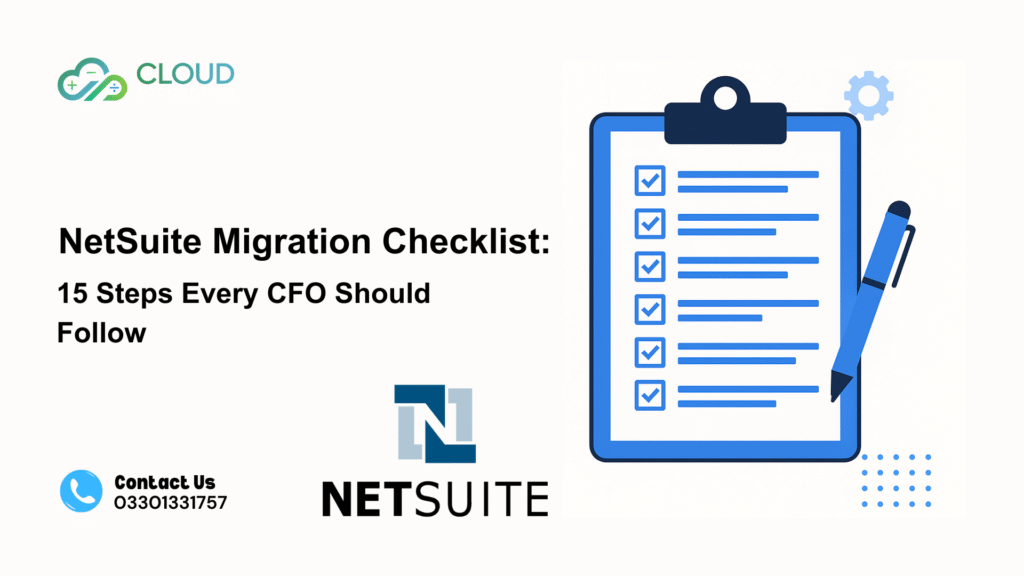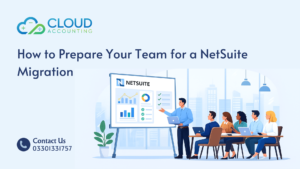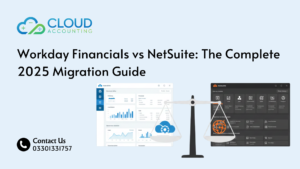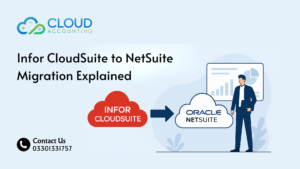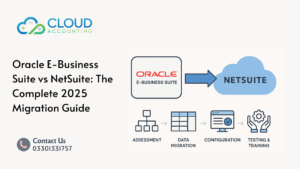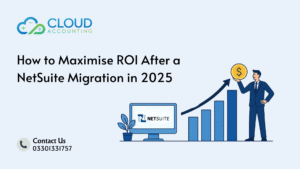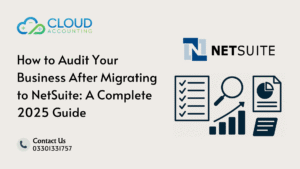Migrating to NetSuite is one of the most important projects a CFO can oversee. Done right, it delivers stronger reporting, compliance, and scalability. Done wrong, it risks financial errors and costly downtime. That’s why every finance leader needs a structured NetSuite Migration Checklist to stay on track.
This guide covers 15 actionable steps designed specifically for CFOs—so you can lead your organisation through a successful migration with confidence.
Why CFOs Need a NetSuite Migration Checklist
As the financial steward of the business, a CFO cannot afford to let data accuracy, compliance, or timelines slip during migration. ERP projects are complex, but a NetSuite Migration Checklist keeps the process organised.
Without a checklist, common risks include:
- Incomplete or duplicated data.
- Delayed go-live dates.
- Compliance gaps in tax or multi-currency reporting.
By following a structured approach, CFOs ensure every stage of the NetSuite migration process is carefully planned, tested, and validated.
15-Step NetSuite Migration Checklist for CFOs
The following steps outline the ultimate ERP migration checklist for finance leaders.
1. Define migration goals & scope
Every migration starts with clarity. CFOs should define:
- Which business units will migrate.
- Reporting and compliance goals.
- Success metrics for the project.
This ensures your NetSuite Migration Checklist aligns with strategic objectives.
2. Audit your existing accounting or ERP system
Understand what data and processes you are moving. Document:
- Current chart of accounts.
- Open invoices and payables.
- Custom reports and workflows.
A proper audit prevents gaps in the NetSuite implementation steps later.
3. Clean & prepare financial data
Before migration, resolve issues such as:
- Duplicate supplier or customer records.
- Old transactions that no longer need migration.
- Incorrect tax codes.
CFOs must lead financial data migration NetSuite efforts to avoid carrying errors forward.
4. Build a cross-functional migration team
A CFO cannot run migration alone. Create a project team including:
- Finance leads.
- IT support.
- External consultants.
This team drives accountability across the NetSuite migration process.
5. Choose the right NetSuite implementation partner
The right partner ensures smooth execution of your NetSuite Migration Checklist. Evaluate firms based on:
- ERP migration experience.
- Industry expertise.
- Post-go-live support offerings.
6. Map legacy data to NetSuite fields
Accurate mapping is essential for ERP success. Focus on:
- Chart of accounts.
- Customer and vendor records.
- Transaction history.
This is one of the most technical NetSuite implementation steps and requires CFO oversight.
7. Develop a detailed project timeline
CFOs should insist on a phased timeline that includes:
- Pilot migration testing.
- Validation milestones.
- Training schedules.
A timeline anchors the ERP migration checklist in realistic deadlines.
8. Back up all existing financial records
Before any transfer, create secure backups. This includes:
- All financial transactions.
- Tax filings.
- Payroll data.
This safety net protects the business if any part of the NetSuite migration process needs rollback.
9. Configure NetSuite for your business needs
ERP systems are not one-size-fits-all. CFOs should confirm:
- Chart of accounts alignment.
- Tax rules for each jurisdiction.
- User roles for compliance.
Configuration ensures the NetSuite Migration Checklist supports long-term strategy.
10. Test migration with pilot runs
Never migrate all data at once. Instead, run pilots with:
- A subset of transactions.
- Multi-currency test cases.
- Compliance reporting.
This provides early feedback for migration testing and support before full migration.
11. Validate accuracy of financial reports
After pilot runs, CFOs must confirm:
- Balance sheets match legacy data.
- Income statements reconcile.
- Cash flow reports align.
This step confirms the NetSuite Migration Checklist is producing accurate financial outputs.
12. Assign user roles & permissions
NetSuite security is key. CFOs should define:
- Finance team permissions.
- Audit trails for compliance.
- Restricted access for sensitive data.
This step strengthens the ERP migration checklist with governance.
13. Train finance team & other staff
Without training, adoption will fail. Provide:
- Hands-on workshops.
- Role-specific training modules.
- Post-migration support sessions.
This ensures smooth post-migration training and staff readiness.
14. Plan your NetSuite go-live strategy
Going live is high risk. CFOs should plan:
- Cutover dates outside financial close.
- Parallel runs for safety.
- IT monitoring during launch.
A controlled NetSuite go-live strategy minimises disruption.
15. Establish ongoing support & monitoring
ERP migration doesn’t end at go-live. CFOs must:
- Monitor system performance.
- Schedule audits.
- Engage continuous improvement.
With the right partner, your NetSuite Migration Checklist becomes a roadmap for long-term success.
Common Pitfalls CFOs Face During NetSuite Migration
Even with planning, CFOs often fall into traps such as:
- Rushing through planning stages.
- Failing to validate data mapping.
- Underestimating multi-currency or tax rules.
- Skipping post-migration training.
Avoiding these mistakes ensures the CFO NetSuite migration process runs smoothly.
How Cloud Accounting Helps CFOs with Migration
A CFO’s role during ERP transition is demanding, and having the right partner makes all the difference. At Cloud Accounting, we specialise in guiding finance leaders through every part of the NetSuite migration process, ensuring projects are delivered on time, within budget, and without data errors.
Here’s how we support CFOs:
- End-to-end planning and execution
From the initial system audit to the final go-live, we create a tailored NetSuite Migration Checklist for your business. This ensures every stage—data preparation, configuration, and training—is handled in a structured way. - Expert NetSuite implementation steps tailored to your industry
Whether you’re in retail, wholesale, manufacturing, or professional services, we understand the unique reporting and compliance requirements. Our team adapts the NetSuite implementation steps to your sector, so financial reporting, tax rules, and approval workflows are set up correctly from day one. - Data validation and compliance checks
CFOs need confidence that every transaction, balance sheet, and tax report is accurate. We perform rigorous ERP data validation and reconciliation to ensure NetSuite matches your legacy system records. This eliminates the risk of audit issues and financial reporting errors. - Ongoing post-migration support
Migration doesn’t end at go-live. We provide continuous migration testing and support, plus post-migration training for your finance team. This means your staff can confidently handle NetSuite’s features, and you have access to expert troubleshooting whenever required. - CFO-focused advisory
Beyond technical migration, we help CFOs optimise NetSuite for decision-making. This includes designing management dashboards, automating reporting, and ensuring compliance across multi-entity or multi-currency operations.
With Cloud Accounting as your trusted partner, your CFO NetSuite migration will be smoother, safer, and strategically aligned with your business goals.
CTA: Book a free consultation today to see how we can support your NetSuite Migration Checklist and give your finance team the confidence to move forward.
Final Thoughts
A CFO’s leadership is vital during any ERP transition. Every decision—whether it’s choosing the right implementation partner, validating financial reports, or setting a go-live date—has long-term implications for compliance and business growth. By following this 15-step NetSuite Migration Checklist, you create a clear roadmap that reduces risk, protects data integrity, and ensures accurate financial reporting.
It’s important to remember that migration is not just a technical project—it’s a transformation of how your finance team works. A structured ERP migration checklist ensures smoother adoption, stronger user confidence, and fewer post-go-live issues. CFOs who take ownership of this process are better positioned to deliver:
- Accurate and reliable financial data.
- Improved visibility across global operations.
- Scalable systems that support business expansion.
At Cloud Accounting, we specialise in guiding CFOs through every stage of the NetSuite migration process. From data preparation to post-migration training, our team ensures your organisation avoids common pitfalls and achieves long-term ERP success.
Partner with Cloud Accounting today for a smoother, safer migration—and give your finance team the confidence to thrive with NetSuite.

